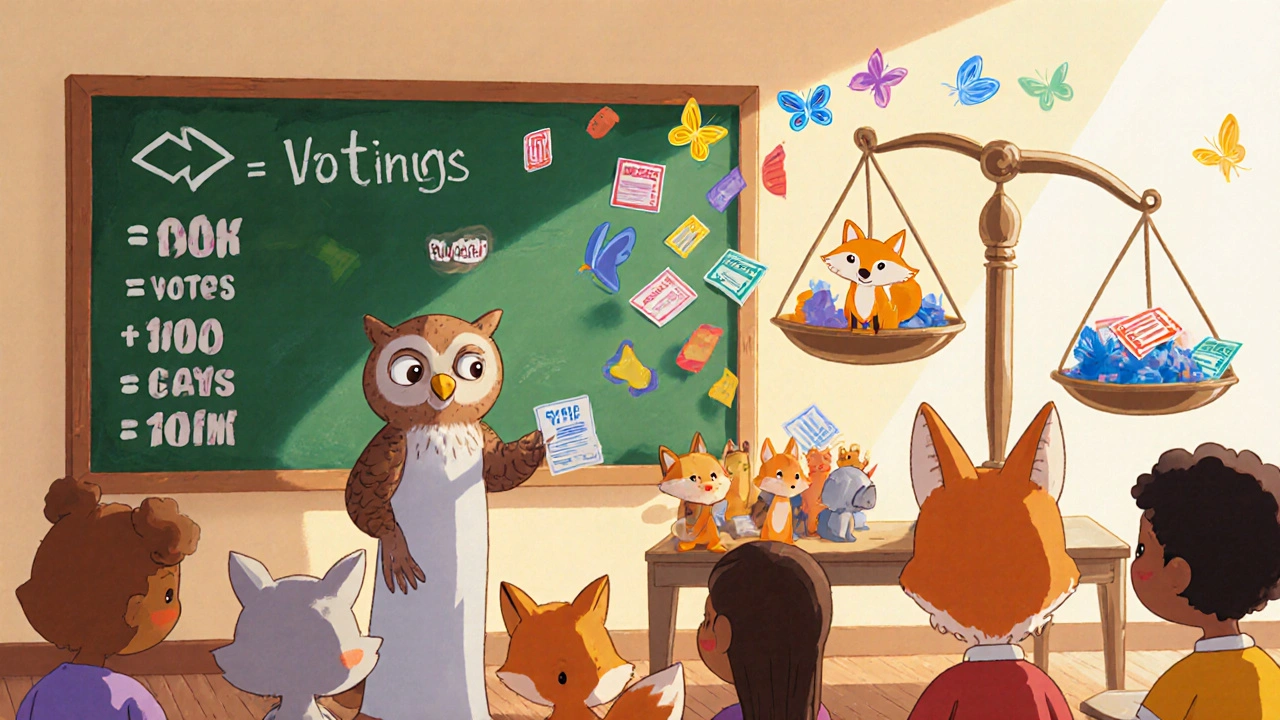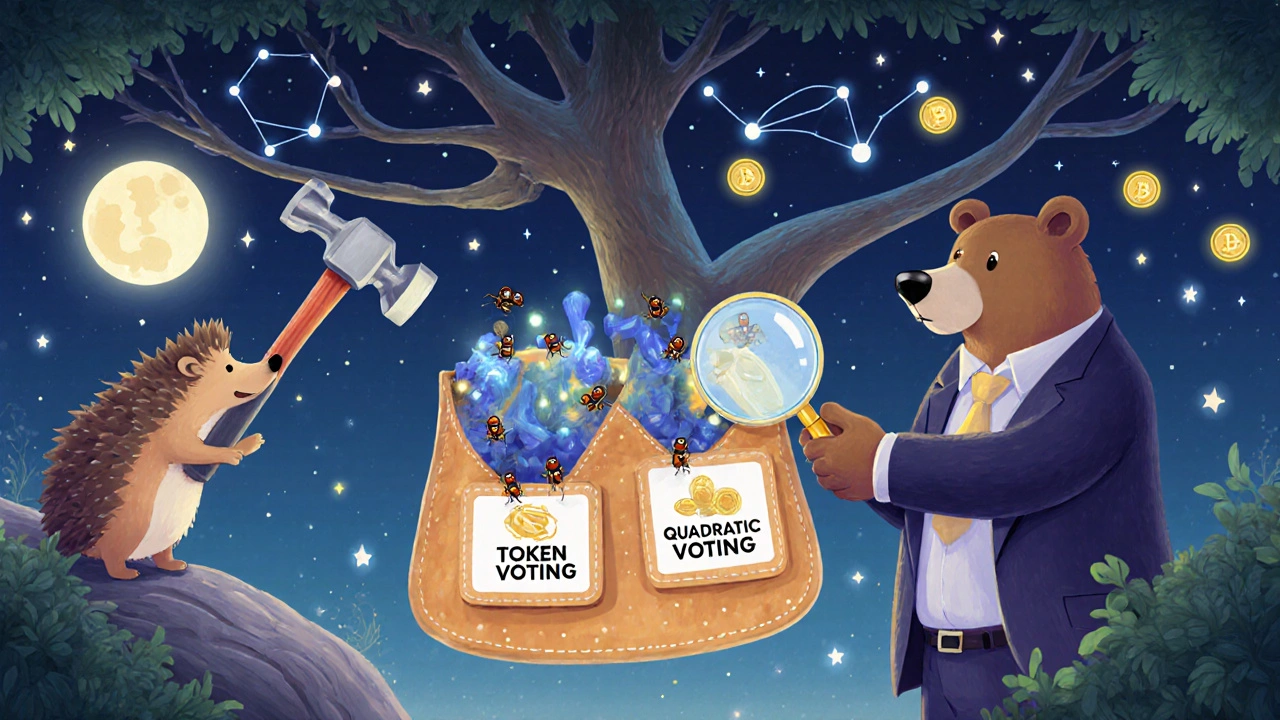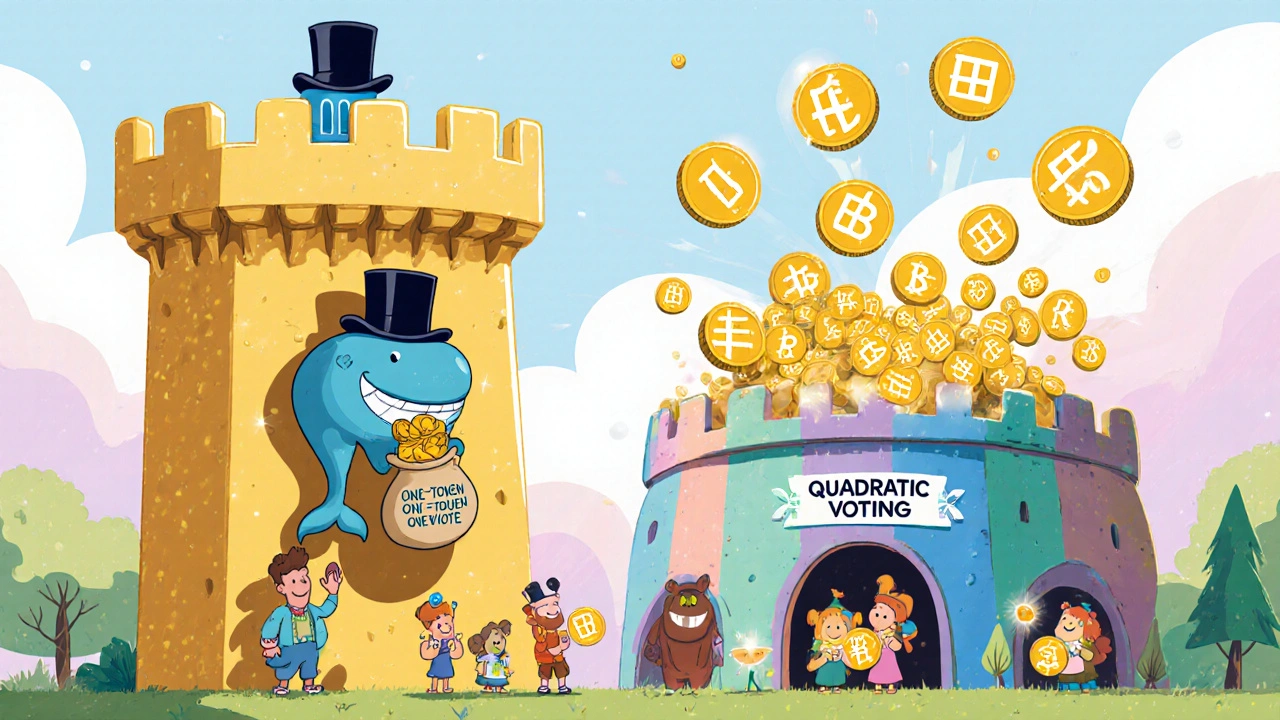When you hold a governance token in a DAO, you’re not just owning a piece of a blockchain project-you’re holding a vote. That vote can decide how millions in treasury funds are spent, whether a protocol gets upgraded, or if a new feature gets built. But here’s the problem: not all votes are created equal. Two main systems fight for control over how those votes are counted: one-token-one-vote and quadratic voting. One is simple, fast, and dominated by big holders. The other is complex, fairer for small contributors, but hard to use. Which one works better? It depends on what you’re trying to achieve.
How One-Token-One-Vote Works
One-token-one-vote is the original model. It’s straightforward: if you own 100 tokens, you get 100 votes. If you own 10,000, you get 10,000 votes. This system was used by early DAOs like The DAO in 2016 and became the default for most protocols since then. MakerDAO, Compound, Uniswap, and Aave all use it. It’s easy to build, easy to understand, and fast to execute.
The math is simple. No formulas. No calculations. Just count the tokens. Smart contracts handle it automatically. If you have enough tokens, you can even submit a proposal yourself. Compound requires at least 100,000 COMP tokens to propose a change, and 4% of all tokens must vote for a proposal to pass. That’s not a lot of people-just the whales.
This model rewards those who invest the most. It makes sense from a financial standpoint: if you’ve put in the most money, you should have the most say, right? But here’s the catch: it turns governance into a game of who owns the biggest wallet. In Q1 2024, the top 10 token holders in Curve DAO controlled 64.3% of all voting power. That means 90% of the community had less influence than a single large holder. One user on Reddit summed it up: “I’ve held UNI for three years. My 50 tokens don’t move the needle when whales control millions.”
Why Quadratic Voting Was Created
Quadratic voting was invented to fix this imbalance. It was first proposed by economist Glen Weyl in 2012 and adapted for blockchain in 2018 by Gitcoin and 1Hive. Instead of one token = one vote, quadratic voting uses a square root formula: votes = √(tokens).
Let’s say you have 100 tokens. Under one-token-one-vote, you get 100 votes. Under quadratic voting, you get 10 votes (√100 = 10). But here’s the twist: if you have 10,000 tokens, you only get 100 votes (√10,000 = 100). That’s the same as someone with 100 tokens. The system makes it exponentially more expensive to buy influence.
This means a whale with 1 million tokens gets only 1,000 votes-not 1 million. Meanwhile, 1,000 small holders with 100 tokens each get 10 votes apiece, totaling 10,000 votes. Suddenly, the crowd has more power than the few.
Gitcoin’s funding rounds show this works. In their 14th round, users who donated less than $100 made up 83% of all voters. Under one-token-one-vote, they’d have gotten only 12% of the matching funds. With quadratic voting, they got 47%. That’s not a fluke-it’s by design. The system rewards passionate, distributed participation over concentrated wealth.
The Trade-Off: Simplicity vs. Fairness
One-token-one-vote wins on speed and simplicity. DAOs using this model can pass decisions in under 48 hours. Most users understand it instantly. Platforms like Snapshot make it easy to vote with just a wallet connection. According to Krayon Digital’s 2024 survey, 92% of token-based DAOs can execute votes within two days.
Quadratic voting? Not so fast. It takes longer to build. Gitcoin’s system required 37% more development time than basic token voting. The interface is harder to design. Users need to understand why 100 tokens don’t equal 100 votes. Only 34% of new users can correctly predict their voting power without guidance. That’s a huge barrier.
Participation rates reflect this. Token-based systems see 63% active voting when delegation is enabled. Quadratic systems struggle to hit 35%. Trustpilot reviews show token-based DAO platforms average 4.1/5 stars for ease of use. Quadratic platforms? 3.3/5. Common complaints: “Too confusing,” “I didn’t know how my vote counted,” “I accidentally gave tokens to the wrong project.”

Where Each Model Shines
There’s no one-size-fits-all. The best model depends on what you’re voting on.
For treasury decisions-like paying developers, buying assets, or emergency upgrades-speed and decisive action matter. One-token-one-vote works here. Uniswap and Aave use it for protocol changes because they need clear, fast outcomes. If a critical bug appears, you don’t want 10,000 people debating for weeks. You want the people with the most skin in the game to act.
For funding public goods-like open-source tools, educational content, or developer grants-fairness matters more than speed. That’s where quadratic voting shines. The Ethereum Foundation has used it since 2020 to distribute millions in grants. Gitcoin’s model has funded thousands of small projects that would’ve been ignored under token-weighted voting. It’s not about who has the most money. It’s about who cares the most.
Hybrid Systems Are the Future
Most new DAOs aren’t choosing one or the other anymore. They’re mixing them.
Optimism’s “Citizen House” uses quadratic voting to fund public goods and one-token-one-vote for protocol upgrades. Aragon’s New Court module, launched in May 2024, adds reputation-based weighting to token voting. Snapshot introduced delegated quadratic voting in April 2024-now used by over 1,200 DAOs.
This isn’t just theory. It’s happening. As of July 2024, 37% of new DAOs use hybrid models. The Ethereum Foundation just gave $20 million to standardize quadratic voting. And industry analysts agree: by 2026, 60% of major DAOs will use multi-layered systems.
Why? Because governance isn’t one thing. It’s many things. You need different tools for different jobs. You wouldn’t use a sledgehammer to hang a picture. You wouldn’t use a scalpel to break down a wall. Same here.

Regulation and Adoption
Both models face legal uncertainty. The SEC’s 2023 lawsuit against Uniswap questioned whether governance tokens are securities. If regulators decide they are, voting rights could be restricted or banned. That affects both models equally.
Corporate DAOs-like those built on ConsenSys’ Infura-stick with token-based voting. 87% use it for treasury management. Why? Because they need predictability. Investors want to know who’s in charge.
Public goods initiatives? Quadratic voting is winning. 68% of Ethereum Foundation grants now use it. It’s the only system that gives small contributors real power.
Gartner’s 2024 Hype Cycle says token-based voting is on the “Plateau of Productivity.” It’s proven, stable, widely used. Quadratic voting? Still in the “Peak of Inflated Expectations.” Too many people think it’s a magic fix. But the real winners will be those who understand: it’s not about which model is better. It’s about which one fits the job.
What Should You Do?
If you’re building a DAO:
- Use one-token-one-vote if you need fast, decisive governance for treasury, upgrades, or core protocol changes.
- Use quadratic voting if you’re funding public goods, community projects, or want to empower small contributors.
- Consider a hybrid: token voting for core decisions, quadratic for community grants.
If you’re a holder:
- Check how your DAO votes. If it’s one-token-one-vote, and you’re not a whale, consider delegating your vote to someone who’s active.
- If it’s quadratic, take the time to learn how it works. Your small vote matters more than you think.
There’s no perfect system. But there are better fits for different needs. The future of governance isn’t about picking one model. It’s about matching the right tool to the right decision.
What’s the difference between one-token-one-vote and quadratic voting?
One-token-one-vote gives each token exactly one vote, so wealth equals influence. Quadratic voting uses a formula where votes equal the square root of tokens held. This means owning 100 tokens gives you 10 votes, and 10,000 tokens gives you 100 votes-making it much harder for large holders to dominate decisions.
Which model is more common in DAOs?
One-token-one-vote is used by 83% of active DAOs as of 2024, according to Chainalysis. Quadratic voting is used in about 9%, mostly in public goods funding projects like Gitcoin Grants and Ethereum Foundation grants.
Why do whales dominate one-token-one-vote systems?
Because voting power is directly proportional to token holdings. A single holder with 1 million tokens has 1 million votes. Even if 10,000 small holders each have 100 tokens, their combined 1 million votes still equal one whale’s vote. In practice, whales often coordinate to vote as a bloc, controlling outcomes.
Can quadratic voting be hacked or manipulated?
Yes. Critics like Professor Emin Gün Sirer warn that coordinated sybil attacks-where many small accounts vote together-can distort outcomes. That’s why modern quadratic systems now include anti-sybil measures like identity verification, reputation scores, or time-based voting limits. Gitcoin’s 2024 update patched several known vulnerabilities.
Is quadratic voting harder for regular users to understand?
Absolutely. Only 34% of new users can correctly predict their voting power without guidance, according to Gitcoin’s user testing. The square root math isn’t intuitive. That’s why many quadratic systems now include built-in calculators and tooltips. Token-based voting is simpler-just count your tokens.
Are governance tokens considered securities?
The SEC has raised concerns, especially after its 2023 lawsuit against Uniswap. If regulators classify governance tokens as securities, voting rights could be restricted or require compliance with financial regulations. This affects both voting models and is one of the biggest legal risks facing DAOs today.
What’s the future of DAO voting?
Hybrid models are the future. Leading DAOs are combining token-based voting for core decisions with quadratic voting for community funding. Some are adding reputation systems or time-weighted voting. By 2026, experts predict 60% of major DAOs will use multi-layered governance-not one model for everything.
